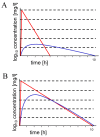New Antibiotics for the Treatment of Nosocomial Central Nervous System Infections
- PMID: 38247617
- PMCID: PMC10812395
- DOI: 10.3390/antibiotics13010058
New Antibiotics for the Treatment of Nosocomial Central Nervous System Infections
Abstract
Nosocomial central nervous system (CNS) infections with carbapenem- and colistin-resistant Gram-negative and vancomycin-resistant Gram-positive bacteria are an increasing therapeutic challenge. Here, we review pharmacokinetic and pharmacodynamic data and clinical experiences with new antibiotics administered intravenously for the treatment of CNS infections by multi-resistant bacteria. Cefiderocol, a new siderophore extended-spectrum cephalosporin, pharmacokinetically behaves similar to established cephalosporins and at high doses will probably be a valuable addition in our therapeutic armamentarium for CNS infections. The new glycopeptides dalbavancin, telavancin, and oritavancin are highly bound to plasma proteins. Although effective in animal models of meningitis, it is unlikely that they reach effective cerebrospinal fluid (CSF) concentrations after intravenous administration alone. The β-lactam/β-lactamase inhibitor combinations have the principal problem that both compounds must achieve adequate CSF concentrations. In the commercially available combinations, the dose of the β-lactamase inhibitor tends to be too low to achieve adequate CSF concentrations. The oxazolidinone tedizolid has a broader spectrum but a less suitable pharmacokinetic profile than linezolid. The halogenated tetracycline eravacycline does not reach CSF concentrations sufficient to treat colistin-resistant Gram-negative bacteria with usual intravenous dosing. Generally, treatment of CNS infections should be intravenous, whenever possible, to avoid adverse effects of intraventricular therapy (IVT). An additional IVT can overcome the limited penetration of many new antibiotics into CSF. It should be considered for patients in which the CNS infection responds poorly to systemic antimicrobial therapy alone.
Keywords: avibactam; cefiderocol; cerebrospinal fluid; dalbavancin; eravacycline; meningitis; relebactam; tazobactam; vaborbactam; ventriculitis.
Conflict of interest statement
The authors declare no conflicts of interest.
Figures

Similar articles
-
Cefiderocol: A Siderophore Cephalosporin with Activity Against Carbapenem-Resistant and Multidrug-Resistant Gram-Negative Bacilli.Drugs. 2019 Feb;79(3):271-289. doi: 10.1007/s40265-019-1055-2. Drugs. 2019. PMID: 30712199 Review.
-
Imipenem-Relebactam and Meropenem-Vaborbactam: Two Novel Carbapenem-β-Lactamase Inhibitor Combinations.Drugs. 2018 Jan;78(1):65-98. doi: 10.1007/s40265-017-0851-9. Drugs. 2018. PMID: 29230684 Review.
-
Treatment of infections caused by multidrug-resistant Gram-negative bacilli: A practical approach by the Italian (SIMIT) and French (SPILF) Societies of Infectious Diseases.Int J Antimicrob Agents. 2024 Jul;64(1):107186. doi: 10.1016/j.ijantimicag.2024.107186. Epub 2024 Apr 28. Int J Antimicrob Agents. 2024. PMID: 38688353 Review.
-
Rationale and evidence for the use of new beta-lactam/beta-lactamase inhibitor combinations and cefiderocol in critically ill patients.Ann Intensive Care. 2023 Jul 18;13(1):65. doi: 10.1186/s13613-023-01153-6. Ann Intensive Care. 2023. PMID: 37462830 Free PMC article. Review.
-
Clinical data from studies involving novel antibiotics to treat multidrug-resistant Gram-negative bacterial infections.Int J Antimicrob Agents. 2022 Sep;60(3):106633. doi: 10.1016/j.ijantimicag.2022.106633. Epub 2022 Jul 1. Int J Antimicrob Agents. 2022. PMID: 35787918 Review.
Cited by
-
Role of Cefiderocol in Multidrug-Resistant Gram-Negative Central Nervous System Infections: Real Life Experience and State-of-the-Art.Antibiotics (Basel). 2024 May 16;13(5):453. doi: 10.3390/antibiotics13050453. Antibiotics (Basel). 2024. PMID: 38786181 Free PMC article.
-
Increased Antibiotic Susceptibility of Gram-Positive Bacteria in Cerebrospinal Fluid Compared to Broth.Antibiotics (Basel). 2024 Dec 14;13(12):1215. doi: 10.3390/antibiotics13121215. Antibiotics (Basel). 2024. PMID: 39766605 Free PMC article.
-
Treatment Options for Nosocomial Ventriculitis/Meningitis: A Case Report and Review of the Literature.Pathogens. 2024 Dec 26;14(1):3. doi: 10.3390/pathogens14010003. Pathogens. 2024. PMID: 39860964 Free PMC article. Review.
-
Aztreonam plus ceftazidime-avibactam for post-neurosurgical meningitis due to Stenotrophomonas maltophilia.Antimicrob Agents Chemother. 2025 Aug 6;69(8):e0017225. doi: 10.1128/aac.00172-25. Epub 2025 Jun 2. Antimicrob Agents Chemother. 2025. PMID: 40455001 Free PMC article.
-
Case Commentary: Overcoming intrinsic resistance-the successful use of aztreonam and avibactam for Stenotrophomonas maltophilia meningitis.Antimicrob Agents Chemother. 2025 Aug 6;69(8):e0064025. doi: 10.1128/aac.00640-25. Epub 2025 Jul 9. Antimicrob Agents Chemother. 2025. PMID: 40631961 Free PMC article.
References
-
- Shi J., Sun T., Cui Y., Wang C., Wang F., Zhou Y., Miao H., Shan Y., Zhang Y. Multidrug resistant and extensively drug resistant Acinetobacter baumannii hospital infection associated with high mortality: A retrospective study in the pediatric intensive care unit. BMC Infect. Dis. 2020;20:597. doi: 10.1186/s12879-020-05321-y. - DOI - PMC - PubMed
-
- Fursova N.K., Fursov M.V., Astashkin E.I., Fursova A.D., Novikova T.S., Kislichkina A.A., Sizova A.A., Fedyukina G.N., Savin I.A., Ershova O.N. Multidrug-Resistant and Extensively Drug-Resistant Acinetobacter baumannii Causing Nosocomial Meningitis in the Neurological Intensive Care Unit. Microorganisms. 2023;11:2020. doi: 10.3390/microorganisms11082020. - DOI - PMC - PubMed
Publication types
LinkOut - more resources
Full Text Sources

